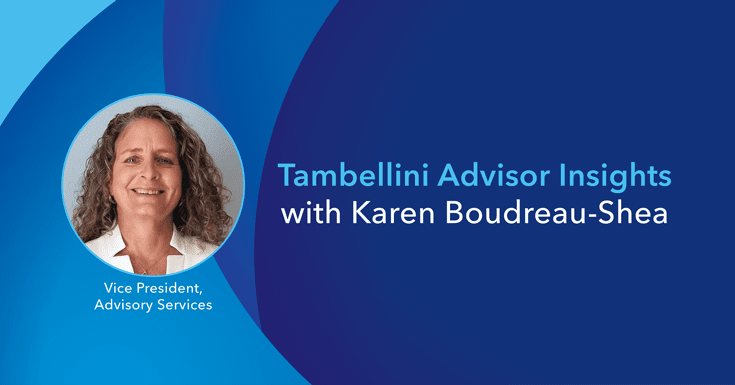Why Strategic Alignment Matters More Than Budget Size
Former Tambellini Author

An Interview with Karen Boudreau-Shea, Vice President, Advisory Services
The impact of financial strains is top of mind for higher education technology stakeholders: Respondents to Campus Technology’s 2022 Digital Transformation Survey cited “budget restrictions” as the top obstacle thwarting their progress toward digital transformation, and 41 percent of respondents to Educause’s 2021 Dx QuickPoll cited “overall costs and affordability” as “major barriers.”
It’s understandable why many leaders regard funding limitations as a formidable hurdle: The direct and indirect costs of investing in new platforms, upgrading existing tools, and implementing new ones are higher than ever before. Meanwhile, declining enrollments and continuing economic uncertainty compound downward pressure on operating budgets.
But when it comes to leveraging technology to spur impactful change and improvement, Karen Boudreau-Shea, Tambellini Group’s Vice President of Advisory Services, says many institutions face a more significant impediment that has little to do with money: a lack of strategic enterprise alignment.
In this interview, Karen shares her insider’s perspective from more than 25 years of experience helping numerous North American institutions implement their technology and business initiatives. She also offers expert tips for how institutions can better align their technology initiatives with overall institutional goals.
Question 1: With so many higher education technology leaders reporting that budget constraints impede technology progress at their institutions, why do you think strategic alignment is a bigger issue?
There’s no denying that money and other resources are vital. Still, the tendency to hyperfocus on price as the main factor in selecting a technology tool often comes at the expense of assessing how it fits into the bigger picture of an institution’s overall goals. I see so many efforts underway that cost time and money without contributing to any substantive, strategic change that meets the changing pace of our world.
On the opposite end of the spectrum, some institutions have had the enviable advantage of sufficient funding to purchase every type of technology solution they want. Yet these investments haven’t moved the needle forward on reaching their overall goals because their selections and implementation approaches lacked strategic enterprise alignment and often provide a less-than-connected experience for constituents. Those examples point to the fact that it’s not (just) about money. Even with an unlimited budget, an institution can fail to make progress.
Question 2: How do you define strategic enterprise alignment within the context of technology in higher education? Is there a universal definition?
Every institution’s approach will vary based on its organizational structure and priorities, but in the broadest sense, strategic enterprise alignment requires leadership to begin with its end goal in mind. More specifically, it means intentionally aligning technology strategy and related efforts with organizational goals and operational effectiveness that supports these goals. It doesn’t start with governance, standards, or committees to justify a given transition—though those can all be helpful for gaining clarity and direction, as well as providing forums for discussing how the use of technology is evolving at an institution.
Even when there is a clearly defined institution-wide strategy, many technology decisions are made in ways that are counterproductive to that strategy.
Question 3: The approach you recommend is logical and straightforward. Why aren’t we seeing more institutions following it?
I don’t think any higher education leader purposely ignores this advice: They are seeking out and purchasing technology tools and services with the sincere intention of advancing many initiatives that serve their mission-driven goals. That’s why we see such a massive focus on and investment in technology tools for identifying and engaging with prospective applicants, helping enrolled students succeed, and making institutions more adaptable and user friendly for faculty in teaching and staff in operations. The maturity of the higher education market in integrating organizational strategy at all levels, academically and administratively, is still evolving.
Question 4: So, if higher education leaders are focused on buying and using technology tools to accomplish their central goals, how do their institutions lack strategic alignment?
Most technology decision-makers genuinely believe they are strategic because they are selecting tools that claim to help them accomplish something related to their specific goals. But they often underestimate how important it is to coordinate technology decision-making across departments and functions. That hasn’t traditionally been part of the DNA of postsecondary institutions because they are distributed organizations.
While some might argue that these siloes are inevitable, I think significant changes over the past five to 10 years in how technology vendors market, sell, package, and price technology products and services have compounded the challenges institutions face when attempting to coordinate their decision-making and vet potential solutions for strategic alignment. Most institutions have had their core student and administrative systems for well over 10 years, if not 20 to 30 years.
Those changes have coincided with a growing reliance on and availability of technology tools claiming to serve a wider diversity of goals and priorities important to higher education. So more decisions must be made and coordinated across more institutional functions. It’s a perfect storm.
Question 5: How have pricing models for technology solutions changed and contributed to the lack of strategic alignment and coordination?
Cloud-based SaaS solutions continue to gain adoption, and unlike older on-premise technology platforms, the typical SaaS point solution doesn’t require a substantial up-front investment. Because they often cost less (at first), individual departments now have the resources and freedom to purchase point SaaS solutions using their operating budgets. These are no longer major capital expenditures that require budget approval and buy-in from multiple groups of stakeholders and/or central IT.
Many administrators welcome greater purchasing autonomy and sincerely believe they are the most knowledgeable and qualified to select the best-fit technology tools to achieve their department’s objectives. Their choices aren’t necessarily wrong, but they run a very high risk of assessing their options in a vacuum without considering which tools other departments may already be using.
For instance, we see this a lot in both CRM and integration tools—significant overlaps in institutional software licenses are common because two (or more) different groups have unintentionally purchased the same solution from the same vendor. They could have easily saved 20 to 30 percent on licensing costs, not to mention increased efficiencies, if they took a coordinated, strategic approach to their technology investments. Instead, they will want to consolidate licenses after the fact, which requires additional time and resources and will not result in the best financial outcome when consolidating multiple contracts.
Question 6: What has shifted in terms of how technology vendors market and sell their products and services to higher education?
With so many more technology solutions available, vendors go directly to stakeholders leading specific departments with the sales pitch that “you don’t need IT” to implement and use their tool. That pitch may not be technically inaccurate, but the claim can be misleading and damaging in the long run.
On the one hand, technology tools have become much more user-friendly, and many stakeholders, leaders, and users across various functions in higher education have a more sophisticated understanding of how to use and implement those tools. At the same time, however, these buyers may not have the same level of sophistication in understanding the assumptions behind a sales pitch, especially regarding data.
Predictive analytics tools can be helpful, but may require data that an institution doesn’t collect or must input manually. In either scenario, that tool will have limited usage and application because whoever bought it didn’t consider the additional resources and information needed to produce the data and analytics that inform the institution. There are often assumptions baked into the sales pitch that institutions do not realize may impact the outcomes.
Even when data is readily available and easy to plug into a technology tool, buyers may not be asking the bigger question of whether the resulting analytics and findings will drive their institution to respond with meaningful action aligned with their goals. Knowing many students drop out after failing a particular course is useless unless your institution uses that information to make changes that solve the underlying problem.
When purchasing decisions aren’t strategically aligned, it leads to a lot of technical debt. Buying new technology, customizing its functionality, and limiting the adoption of new features have led to technology in many institutions that is not well understood by their current team and, hence, has diminished utility for meeting current needs.
Question 7: What would you recommend institutions do to ensure strategic enterprise alignment in how they invest in and leverage technology adoption?
It all goes back to starting with the end in mind. Here are two main tips:
- When evaluating new technology solutions, consider how each one fits into a broader strategic approach for meeting a goal.
- Avoid the temptation to believe a shiny new tool will solve a problem merely because it meets your functionality requirements and offers specific features.
Technology investments should be one part of coordinated, complementary changes to people and processes. It’s also vital to have a clearly defined path for making those changes. Completing these steps will likely be time-consuming, but it will ensure that every technology tool you choose aligns with tangible, strategic goals.
Categories
Share Article:

Other Posts From this Author:
© Copyright 2025, The Tambellini Group. All Rights Reserved.